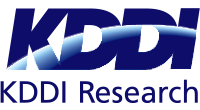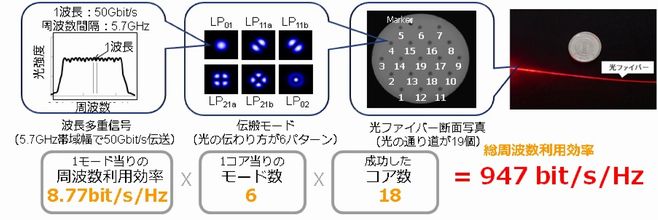 Print
Print
KDDI Research’s Capacity Expanded Technology for Optical Fiber Transmission Demonstrated the World’s Highest Spectral Efficiency, Contributing to the Technology that Supports 5G Mobile Communications
October 14, 2016
KDDI Research, Inc.
SAITAMA, JAPAN, October 14, 2016 -- KDDI Research, Inc., announced today that its technology to highly enhance the spectral efficiency, which is required to expand optical fiber transmission capacity, succeeded to double the record spectral efficiency in a transmission experiment. The archived spectral efficiency of 947 bit/s/Hz is about 60 times higher than that of LTE, Note 1 which is used in 4G mobile communications. The 5G system requires innovations not only in wireless technologies but also in network and optical fiber transmission technologies. Our new technology can be expected to be a key enabler for mobile communications systems with higher throughput and lower latency after 5G and will provide new experiences and services for users.
[Background]
Frequency is an important resource in communications systems. Efficient use of it is indispensable for the large capacity data transmission. With the doubled spectral efficiency, the doubled data can be transmitted with the same frequency bandwidth. The current commercial optical communications system has the spectral efficiency of 2 bit/s/Hz or less, which is less efficient than 15 bit/s/Hz (max.) in LTE. To handle the further increases in data traffic expected in the future, it is indispensable to increase the spectral efficiency in an optical communication system, and technologies to enable it have been actively investigated. Thus far, KDDI Research has used multi-core multi-mode fibers, Note 2 demonstrating a spectral efficiency up to 456 bit/s/Hz.
[Achievements]
In this transmission experiment, we used 64-quadrature amplitude modulation (64QAM) in a 6-mode multiplexed transmission, greatly improving the spectral efficiency. The 64QAM signal transmission uses 64 combinations (signal states) of amplitude and phases of optical signals for data transmission. Therefore, in principle, the spectral efficiency is expected to be tripled, compared to the quadrature phase-shift keying (QPSK: using four phases) used in the previous experiment. Changing four signal states (QPSK) to 64 signal states (64QAM) makes it difficult to obtain good transmission characteristics because the signal with more states is more vulnerable to noise. Therefore, QPSK was the only modulation scheme for multi-mode fiber transmission using six modes or more. In this experiment, we used mode-dependent loss equalization and newly developed six-mode optical amplifiers to enable 64QAM transmission in a six-mode fiber. On September 22, we presented the results at the 42nd European Conference and Exhibition on Optical Communication (ECOC2016) held in Dusseldorf, Germany, and our presentation was highly praised.

[Future Prospects]
The results have brought us closer to an efficient large-capacity optical communications system. We will continue research and development on this system for larger capacity, longer distance, and improved practicality.
Part of this research is based on the results of the research and development for innovative optical fiber and communication technology for exa-bit era with SDM(i-FREE2) (FY 2013-FY 2017) at the National Institute of Information and Communications Technology (NICT).
(Note 1) LTE achieves the maximum transmission speed of 300 Mbit/s at a 20-MHz bandwidth. Therefore, its spectral efficiency is about 300 Mbit/s/20 MHz=15 bit/s/Hz.
(Note 2) This optical fiber can use both multi-core and multi-mode fiber transmission methods. To multiplex different signals, the multi-core method uses multiple cores provided in a single optical fiber, and the multi-mode method uses multiple transmission modes in each core.
Press release on October 1, 2015, “KDDI R&D Laboratories Achieves Ultra-High-Speed Data Transmission of 2 Pbps over Optical Fiber Approximately Double the World’s Previous Maximum Data Transmission Capacity”
※The information contained in the articles is current at the time of publication.Products, service fees, service content and specifications, contact information, and other details are subject to change without notice.